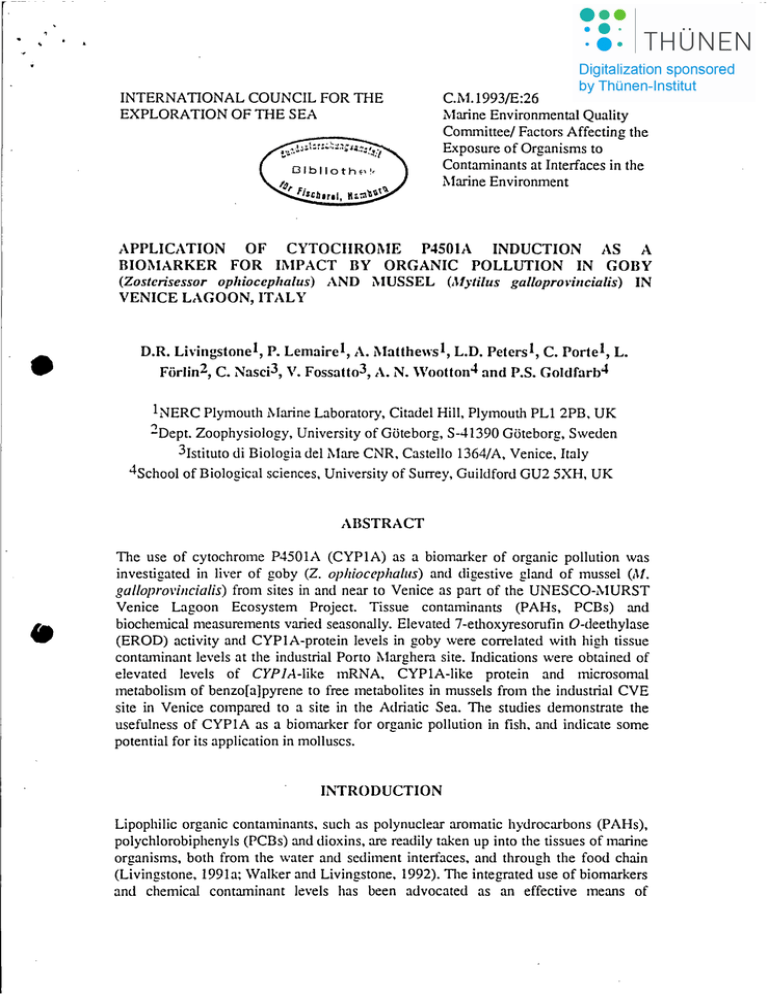Committeel
advertisement

INTERNATIONAL COUNCIL FOR THE
EXPLORATION OF THE SEA
C.M.1993!E:26
Marine Environmental Quality
Committeel Factors Affecting the
Exposure of Organisms to
Contaminants at Interfaces in the
Marine Environment
APPLICATION OF CYTOCIIROME P4501A INDUCTION AS A
BIOMARKER FOR IMPACT BY ORGANIC POLLUTION IN GOßY
(Zosterisessor ophiocephalus) AND MUSSEL (Mytilus ga/loprorillcialis) IN
VENICE LAGOON, ITALY
D.R. Livingstone l , P. LemaireI, A. l\Iatthews l , L.D. Peters l , C. ParteI, L.
Fürlin 2, C. Nasci 3, V. Fossatto3, A. N. \Vootton 4 und P.S. Goldfarb 4
1NERC Plymouth Marine Laboratory, Citadel HilI, Plymouth PLI 2PB, UK
20 ep t. Zoophysiology, University ofGöteborg, S-41390 Göteborg, Sweden
3Istituto di Biologia deI Mare CNR, Castello I 364/A, Venice, Italy
4School of Biological sciences, University of Surrey, Guildford GU2 5XH, UK
ABSTRACT
The use of cytochrome P4501A (CYPIA) as a biomarker of organic pollution was
investigated in liver of goby (2. ophiocepha/us) ami digestive gland of mussei (M.
ga/loprovillcialis) from sites in ami near 10 Venice as part of the UNESCO-~lURST
Venice Lagoon Ecosystem Project. Tissue contaminants (PAHs, PCBs) and
biochemical measurements varied seasonally. Elevated 7-ethoxyresorufin O-deethylase
(EROO) activity ami CYPIA-protein levels in goby \vere correlated with high tissue
contaminant levels at the industrial Porto Marghera site. Indications were obtained of
elevated levels of CYP JA-like mRNA, CYPIA-Iike protein and microsomal
metabolism of benzo[a]pyrene to free metabolites in musseis from the industrial CVE
site in Venice compared to a site in the Adriatic Sea. TIle studies demonstrate the
usefulness of CYPIA as a biomarker for organic pollution in fish, and indicate some
potential for its application in molluscs.
INTRODUCTION
Lipophilic organic contaminants, such as polynuclear aromatic hydrocarbons (PAHs),
polychlorobiphenyls (PCBs) and dioxins, are readily taken up into the tissues of marine
organisms, both from the water ami sediment interfaces, and through the food chain
(Livings1One, 1991a; \Valker and Livingstone, 1992). TIle integrated use of biomarkers
and chemical contaminant levels has been advocated as an effective means of
.'
monitoring the impact of such pollution (~1cCanhy and Shugart, 1990; Stegeman et
al., 1992, Livingstone, 1993). This approach was applied to a study of organic
pollution in Venice Lagoon as part of the UNESCO-MURST Venice Lagoon
Ecosystem Project.
Induction of the biotransformation enzyme cytochrome P4501A (CYPIA) in
liver of fish by PAHs, PCBs. dioxins and other chemicals has been used extensively
worldwide as a biomarker for impact by organic pollution. Responses have been
measured at the level of enzyme activity (7-ethoxyresorufin O-deethylase [EROO] and
benzo[a]pyrene (BaP) hydroxylase activities), enzyme amount or mRNA. To date
some 20 or more successful field studies, involving over 25 species of fish, have been
carried out in Europe and the USA (Livingstone, 1993). Use of the biomarker in fish is
based on a fundamental understanding of the properties ami regulation of the enzyme
(Goksoyr and Förlin, 1992). ~fuch less is known of the enzyme in molluscs such as
sessile bivalves, and the success of field results using various measurements of
cytochrome P450, or the mixed-function oxygenase (MFO) system, has been limited
(Livingstone, 1991a, b). However. recent studies indicate the existence of a CYPIAlike enzyme in MytilliS sp. (Porte er al., 1993; Wootton er al., 1993) with possible
potential for biomonitoring. ~feasurements of CYPIA were made in liver of goby
(Zosterisessor ophioceplzalllS) ami digestive gland of mussei (MytilliS
galloprovincialis) from industrial and other sites in and near Venice Lagoon.
~IATERIALS A~D
l\IETIIODS
~fale and female gobies and musseIs were collected for chemical and biochemical
detenninations at several times of the year from putative clean and polluted sites.
ll1ese included Lio Grande ami Crevan (N. Venice lagoon) and Porto Marghera
(central lagoon - industrial) for goby, ami Platform site (Adriatic Sea) and CVE
(centrallagoon - industrial) for musseI (Fig. 1). Eiiher individual goby livers or pooled
musseI digestive glands were used. ll1e numbers of sampIes taken are given in the text.
Tissues were immediately dissected out, frozen in liquid nitrogen. and stored at -70 °C
before use.
Chemicals and biochemicals \vere of AnalaR grade or equivalent. Following
alkaline saponification, hexane extraction and aluminalsilica gel chromatography,
hydrocarbons ami PCBs were measured by fluorometry and gas chromatography
(Fossato et al., 1989). Cytosolic (9,000g) ami microsomal (100,000g resuspended
pellet) fractions were prepared by standard procedures in 0.15 M KCIIl mM EOTA
pH 7.5 (goby) or 10 mM Tris-HCI/O.5 ~f sucrose/0.15 M KCI pH 7.6 (musseI) (20 %
w/v glycerol was included in microsomal buffer) (Livingstone. 1988; Livingstone et al.,
1992). EROO activity was measured fluorometrically (Burke 'ami Mayer, 1974) in
hepatic 9000g or microsomal fractions of goby. Metabolism of BaP to free metabolites
(dihydrodiols, phenols, tliones) was measured radiometrically, in the presence of
NAOPH using 3H-BaP, in digestive gland microsomes of musseI (Lemaire er al.
(1993). Free polar metabolites were resolved by reverse phase HPLC and quantified by
on-line radiometric counting. Western blotting for CYPIA was carried out on goby
and mussel microsomes as described by Towbin el al. (1979) using polyclonal antiCYPIA from perch (Perca j711viatilis) (alkaline phosphatase visualization, quantified
by image analysis). Analysis of CYP 1Al-like mRNA in musseI digestive gland was
carried out by RNAzol B extraction of RNA and Northem blotting using 32p_
radiolabelled cDNA probe for CYPIAI (pfP1450-3' from rainbow trout Oncorhynchus mykiss) as described in Wootton el af. (1993). Values are given as
mean ± SEM and were compared by one-way analysis of variance (P < 0.05).
RESULTS AND DISCUSSION
Preliminary results for goby liver and mussei digestive gland are presented in
respectively Tables 1 anc12. Total PCB levels are given for goby, and PCBs. PAHs and
Fic:ure 1. Anima! collection sites in Venice Lac:oon and the Adriatic Sea. Gobv
.
(Zosterisessor ophiocephalus) : Lio Grande (2), Crevan (3) and Porto Marghera (4 industrial site); mussei (A{willls gllllopnH'incill/is) : Platfonn sire (1) and CVE (5 industria! site).
~
~
aliphatie hydroearbons for musse!. Tissue contaminant levels changed seasonally in
both goby aml mussei (seasonal data shown only for goby - Table 1), possibly
reflecting variation in discharge and metabolism of contaminants, but most likely due
to changes in tissue lipid levels (\Valker and Livingstone, 1992). Contaminants were
generally highest in both goby and mussei at the industrial sites of respectively Porto
Marghera (Table 1) and CVE (Table 2). Maximal PCB levels were higher in goby than
mussei (18,11 0 compared to 1,461 ng g-1 dry weight), consistent with the low level of
metabolism of PCB congeners by marine organisms and their bioaccumulation to
highest levels at the top of food chains (\Valker and Livingstone, 1992). In contrast,
PAHs are metabolised and eliminated much faster by fish than moHuses (Walker and
Livingstone, 1992), and tissue levels of these contaminants were generally lower in
goby liver than mussei digestive gland (data not shown).
Hepatie ERGO activity was generally similar in male and fe male goby, but
changed considerably with season (Table 1), consistent with observations for other fish
species (GoksDyr and Förlin, 1992: Livingstone, 1993). However, ERGO activity in
both male aml fe male goby was higher at Porto ~targhera than at Crevan on all
sampling occasions (x 3 - x 57 higher), and, to a lesser extent, \vas also higher at Lio
Grande than at Crevan (up to x 5). A similar pattern was observed for levels of
CYP4501A protein, riz. far selected sampies from June in arbitrary units 2.76 ± 0.71
Table 1. Hepatie 7-ethox:Tesorufin O-deethylase (ERGO) acuvlty and total
polychlorobiphenyl (PCB) levels in goby (2. oplzioceplzalus) at different times of the
year from Venice Lagoon. Male ERGO (upper values), female ERGO (lower values)
and total PCBs in unsexed single Iivers (square parenthesis).
CoHection time
Lio Grande
Crevan
Porto Marghera
April 1992
14.1 ± 3.4
*
13.5 ± 2.8 *
3.0 ±0.7 #
39.6 ± 0.2 x
[2727]
3.7 ± 0.5 #
[1993]
20.3 ± 3.6
[8863]
*
2.3 ± 0.3 *
4.6± 0.6
*
2.9±0.7 *
142±15#
[ 1240]
[2250]
164 ± 46 #
[18110]
June 1992
September 1992
5.2± 1.1
13.8 ± 4.8
*
2.9 ± 0.8
22.1 ± 7.0
*
4.6 ± 1.1 #
11.2 ± 4.2 #
[1360]
[7200]
[ 1740)
*
*
17.8 ± 7.2
*
ERGD in pmol min- l mg- 1 protein; total peBs in ng g-1 dry weight; data in the same
row sharing the same symbol (* # x) do not differ signifieantiy (P > 0.05); values are
mean ± SEM (n
= 3 to 6).
4
.
'
.
'
(Porto Marghera), 0.64 ± 0.22 (Lio Grande) and 0.01 ± 0.01 (Crevan) (P< 0.05; n=3).
Thus, on most occasions site-specific differences in ERGD activity paralleled those of
PCB levels. TIle results support the usefulness of hepatic CYP1A induction as a
biomarker for organic pollution in fish (Goksoyr and Förlin, 1992; Livingstone, 1993).
The existence of a CYP1A-like enzyme in marine invertebrates, which is readily
inducible by organic pol1utants such as particular PCBs and PAHs, is as yet unc1ear
(Livingstone, 1991a, 1991b). Hepatic ERGD activity is catalysed solely by CYP1A in
fish (Stegeman, 1989; Goksoyr and Förlin, 1992) and mammals, but is either not
detectable or only present in low activity in invertebrates (Livingstone, 1990, 1991a).
BaP hydroxylase activity is mainly catalysed by CYP1A, plus some other CYP
isoenzymes, in vertebrates (Astrom and DePierre, 1986; Stegeman, 1989), and is
widely detectable in marine invertebrates (Livingstone, 1991a). Apparent induction of
the MFG system has been indicated for some marine invertebrate species, but
responses in most have been absent or low, and certainly much lower than for
vertebrates, e.g 3-fold increases in BaP hydroxylase in the starfish Asrerias rube/ls
(Den Besten er al., 1993), compared to up to several hundred-fold increases for
hepatic ERGD in fish. In field studies with musseis some success has been achieved
with digestive gland BaP hydroxylase activity (Narbonne er al.• 1991), the "418-peak"
(putative denatured CYP450) (Livingstone. 1988) and other biochemical
measurements (Livingstone, 1991b), but as yet no single parameter has emerged as a
widely used biomarker for organic pol1ution in molluscs.
Table 2. Levels of chemical contaminants. Cf? lA-like mRNA, CYP1A-like protein
and microsomal benzo[a]pyrene (BaP) metabolism (to free polar metabolites) in
digestive gland of musseis (M. galloprovincialis) from Venice Lagoon and the Adriatic
Sea (col1ected lune 1992).
•
~leasurement
Platform site
(Adriatic Sea)
CVE
(Venice)
UC~l
a
339
814
PAHs b
149
185
443
1461
10.5 ± 5.6 *
6.0 ± 1.3
1.25 ± 0.61
39.5 ± 0.9
PCBsb
Cf? IA-like mRNA c
CYPIA-like protein c
BaP metabolism d
10.9 ±3.8
3.02 ± 0.93
a Unresolved complex mixture of aliphatic hydrocarbons in Ilg g-ldry weight; b total
polynuc1ear aromatic hydrocarbons (PAHs) ami polychlorobiphenyls (PCBS) in ng g-1
dry weight; carbitrary units; d pmol polar metabolites (sum of dihydrodiols. diones and
phenols) min- 1 mg- 1 protein: * P < 0.05 comparing sites; values are mean ± SEM (n =
3 to 6).
5
"
i-.lore recently, additional evidence has been obtained of the existence of a
CYPIA-like enzyme in digestive gland of musseI. Western blotting of partially purified
CYP450 with perch polyclonal anti-CYPIA gave a single band of 54 kD (Porte er al.,
1993). Similarly, Northern blotting with rainbow trout CYPIAI-cDNA probe gave a
single mRNA band (\Vootton et al.. 1993). 11Iese measurements of CYPIA-like
protein and CYPIA-like mRNA, plus enzyme activity (metabolism of BaP to free
metabolites), were applied to the study of musseis in the Venice area. All three were
either higher, or indicated to be higher, in musseis at the industrial CVE site compared
to the site in the Adriatic Sea (Table 2). Correlation was therefore seen with the higher
levels of hydrocarbons and PCBs at the CVE site (Table 2). The resuits are considered
indicative of the existence of an inducible CYP4501A-like enzyme in mussel and argue
for further study to investigate its biomarker potential.
ACKNOWLEDG El\1ENTS
11Iis work was carried out in the framework of the UNESCO Project "Venice Lagoon
Ecosystem". apart of the ltalian Ministerial Project "Venice Lagoon System", from
which it was partly financed. It also fonns part of Laboratory Project 5 of the
Plymouth Marine Laboratory, a component institute of the UK Natural Environment
Research Council (NERC), and was part carried out under the tenure of an NERC
CASE Ph.D. studentship to A.N. \Vootton. :l11d an EERO postdoctoral fellowship to
P. Lemaire.
REFERENCES
r\strom. A. & DePierre, J.\V., 1986. Rat-liver rnicrosomal cytochrome P-450:
purification. characterization, multiplicity and induction. Biochimica Biophysica Acta.
853, 1-27.
Burke, l\I.D. & Mayer, R.T., 1974. Ethoxyresorufin: direct fluorimetric assay of a
microsomal O-dealkylation which is preferentially inducible by 3-methylcholanthrene .
Drug Metabolism and Disposition. 2. 583-588.
Den Besten, P.J., Lemaire, P., Livingstone, D.R.• \Voodin, B., Stegeman, J.J.,
lIerwig, 11..1. & Seinen, \V., 1993. Time-course and dose-response of the apparent
induction of the eytochrome P450 monooxygenase system of pylorie eaeea
microsomes of the fe male sea star Asterias rube/ls L. by benzo[a]pyrene and
polychlorinated biphenyls. Aquatic Toxicology, 26. 23-40.
Fossato, V.V., Campesan, G•• Craboledda, L. & Stocco, G., 1989. Trends in
chlorinated hydrocarbons and heavy metals in organisms from the Gulf of venice.
Archivio di Oceanografia e Limnologia. 21. 179-190.
Goksoyr, A. & Fürlin, L., 1992. 11Ie cytochrome P-450 system in fish. aquatic
toxicology and environmental monitoring. Aquatic Toxicology, 22. 287-311.
Lemaire, P., Den Besten, P J., O'lIara, S.C.M. & Livingstone, D.R., 1993.
Comparative metabolism of benzo[a]pyrene by microsomes of hepatopancreas of the
shore erab Carcilllls mae/las L. und digestive gland of the common mussei MytilliS
edlilis L. Polycyclic Aromatic Compounds, 3 (Supp!.), 1133-1140.
Livingstone, D.R•• 1988. Responses of microsomal NADPH-cyctochrome c reductase
activity and cytochrome P-450 in digestive glands of MytilliS edlilis ami Littori/la
6
..
. . • .. .
\
"
littorea to environmental and experimental exposure to pollutants. Marine Eeology
Progress Series, 46, 37-43.
Livingstone, D.R., 1990. Cytoehrome P-450 and oxidative metabolism in
invertebrates. Biochemical Society Transactions, 18, 15-19.
Livingstone, D.R., 1991a. Organic xenobiotic metabolism in marine invertebrates.
Advances in Comparative and Environmental Physiology, 7, 45-185.
Livingstone, D.R., 1991 b. Towards a speeifie index of impact by organie pollution for
marine invertebrates. Comparative Biochemistry and Physiology, 100C, 151-155.
Livingstone, D.R., 1993. Biotechnology and pollution monitoring: use of molecular
biomarkers in the aquatie envitonment Journal of Chemical Teehnology and
Bioteehnology, 57, 195-211.
Livingstone, D.R., Archibald, S., Chipman, J.K. & Marsh, J.'V., 1992.
Antioxidant enzymes in liver of dab Limallda limallda from the North Sea. ~tarine
Ecology Porgress Series, 91, 97-104.
I\IcCarthy, J.F. & Shugart, L.R. (eds.), 1990. Biomarkers of environmental
eontamination, Boea Raton, Florida: Lewis Publishers, 457 pp.
Narbonne, J.F., Garrigues, P., Rihera, D., Raoux, C., Mathieu, A., Lemaire, P.,
Salaun, J.P. & Lafaurie, 1\1., 1991. Mixed-function oxygenase enzymes as tools for
pollution monitoring: field studies on the french coast of the Mediterranean Sea.
Comparative Biochemistry and Physiology. 100C,37-42.
Porte. C., Lemaire, P., Peters, L.D. & Livingstone, D.R., 1993. Partial purifieation
and properties of cytochrome P450 from digestive gland microsomes of the common
musseI, Myti/us edulis L. Marine Environmental Research, in press.
Stegeman, J ..1., 1989. Cytochrome P450 fonns in fish: catalytic, immunological and
sequence similarities. Xenobiotica, 19, 1093-1110.
Stegeman, J ..1., ßrouwer, 1\1., Di Giulio. R.T., Förlin, L., Fow)er, ß., Sanders,
ß.1\1. & Van Veld, P.A., 1992. Molecular responses to environmental contamination:
enzyme and protein synthesis as indicators of chemical exposure amI effecl. In:
Biomarkers. Biochemieal, physiologieal, alld histological markers 0/ allthropogellic
stress, ed. R.J. Huggett, R.A. Kimerle, P.l\1. l\tehrle Jr. and H.L. Boea Raton. Florida:
Lewis Publishers, pp. 235-335.
Towbin, 11., Staehelin, T. & Gordon, J .• 1979. Electrophoretic transfer of proteins
from polyacrylamide gels 10 nitrocellulose sheets: procedure amI some applications.
Proceedings of the National Academy of Science, 76, 4350-4355.
'Valker, C.II. & Livingstone, D.R. (eds.), 1992. Persistent Pollutants in Marine
Ecosystems, Oxford: Pergamon Press, 272 pp.
'Vootton, A.N., lIerring, c., Spry, J.A., 'Viseman, A., Livingstone. D.R. &
Goldfarb, P.S, 1~93. Evidence for the existence of cytochrome P450 gene families
(CYPIAI, 3A, 4~11, IIAI) amI modulation of gene expression (CYPIAI) in the mussei
M.vti/us sp.. Marine Environmental Research, in press.
7






